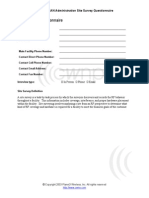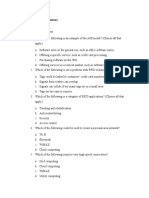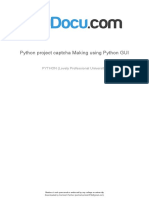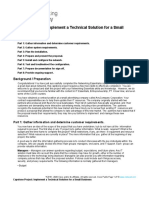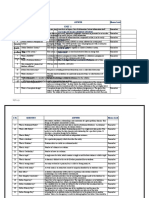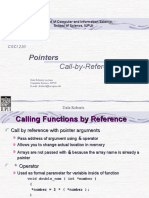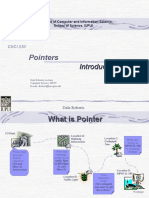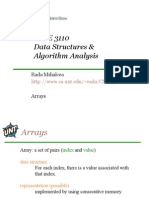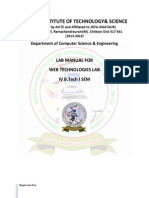Facial Recognition Using LabVIEW
Facial Recognition Using LabVIEW
Uploaded by
Anjali NaiduCopyright:
Available Formats
Facial Recognition Using LabVIEW
Facial Recognition Using LabVIEW
Uploaded by
Anjali NaiduCopyright
Available Formats
Share this document
Did you find this document useful?
Is this content inappropriate?
Copyright:
Available Formats
Facial Recognition Using LabVIEW
Facial Recognition Using LabVIEW
Uploaded by
Anjali NaiduCopyright:
Available Formats
FACIAL RECOGNITION TECHNIQUE FOR SECURITY LOCKING USING LABVIEW AND NI-VISION
ABSTRACT Face recognition is a fascinating topic in the field of computer vision. There are already many face recognition algorithms that exist today, where each has its merits and weakness. One of the most important goals of computer vision is to achieve visual recognition ability comparable to that of human .This project describes an approach in developing a face recognition program using LabVIEW programming language and NI (NATIONAL INSTRUMENTS) Vision Development Module. It has opened a new age for human kind to enter into a new world, commonly known as the technological world. From last two decades, its potential applications, such as in the areas of surveillance, closed circuit television (CCTV) control, (HCI) Human Computer Interface, intelligent robot and so on It has gained increasing interests over the years, especially for biometrics identification and authentication applications in the homeland security . Complex face authentication and recognition systems are very costly, and hence the challenge is to develop a PC-based face recognition system with sufficient reliability at much lower cost. The implementation of the Face Recognition System (FRS) can be subdivided into two main parts. The first part is image processing and the second part is recognition techniques.
The main advantages of face recognition scheme is its speed and simplicity, learning capacity and relative insensitivity to small or gradual changes in the face image. Technological advancements in semiconductor wafers manufacturing have resulted in cheaper microprocessors and computers. LabVIEWs graphical programming environment helps programmer to visualize the program flow, develop and debug easier. Also, as many engineering process and algorithms are presented in flow diagrams, implementing them in LabVIEW is simpler and faster as they naturally correspond to LabVIEWs block diagrams and the use of subVIs.
BLOCK DIAGRAM:
You might also like
- ITECH2301-Network Architecture and DesignDocument10 pagesITECH2301-Network Architecture and DesignBiswajit DuttaNo ratings yet
- Entry Level Local Area Network Design Case StudyDocument15 pagesEntry Level Local Area Network Design Case StudyRowena Clemente0% (2)
- IT 12 Data Communication With Networking OBE Syllabus 1hourDocument8 pagesIT 12 Data Communication With Networking OBE Syllabus 1hourLawrence SisonNo ratings yet
- Child Safety Wearable DeviceDocument3 pagesChild Safety Wearable DevicedileeppatraNo ratings yet
- The TCM Security Pentester RoadmapDocument9 pagesThe TCM Security Pentester Roadmappahadiabhi1030No ratings yet
- E219483 Final Project Proposal 2024Document13 pagesE219483 Final Project Proposal 2024Ravindu PriyankaraNo ratings yet
- Oosd - Cellular Networking Case StudyDocument54 pagesOosd - Cellular Networking Case StudyMohd Zohaib Ali Khan Amanzai100% (1)
- Home Automation Using TelegramDocument28 pagesHome Automation Using TelegramNaveen DhaaramNo ratings yet
- Amity School of Engineering & TechnologyDocument33 pagesAmity School of Engineering & TechnologyGarima Mahendru SaxenaNo ratings yet
- HCIA-Datacom Training and Certification: (Huawei Certified ICT Associate - Datacom)Document1 pageHCIA-Datacom Training and Certification: (Huawei Certified ICT Associate - Datacom)ThjkuiNo ratings yet
- 17 Implementation of A Company Network ScenarioDocument7 pages17 Implementation of A Company Network ScenarioVina UntalanNo ratings yet
- GenetDocument14 pagesGenetgenet habebeNo ratings yet
- Research Paper On Cloud Computing Security IssuesDocument6 pagesResearch Paper On Cloud Computing Security Issuesgz45tyyeNo ratings yet
- Application of IOT Devices For Smart Car Parking SystemDocument11 pagesApplication of IOT Devices For Smart Car Parking SystemabdelrahmanelfakiNo ratings yet
- Computer Science Textbook Solutions - 13Document30 pagesComputer Science Textbook Solutions - 13acc-expertNo ratings yet
- Mobile Computing Previous Papers by JNTUKDocument4 pagesMobile Computing Previous Papers by JNTUKKumara Raja Jetti100% (1)
- FCN SampleDocument5 pagesFCN SampleRoshun GeorgeNo ratings yet
- Course OutlineDocument5 pagesCourse Outlinenahom tesfayeNo ratings yet
- Seminar ReportDocument7 pagesSeminar ReportvanditaNo ratings yet
- Internet Protocols Seminar ReportDocument14 pagesInternet Protocols Seminar ReportAkash NandeNo ratings yet
- Wireless Network QuestionnaireDocument8 pagesWireless Network QuestionnaireZachary JuniorNo ratings yet
- Chapter 3Document11 pagesChapter 3Paolo RenNo ratings yet
- Chapter 8 - Protocol Architecture - Computer NetworksDocument12 pagesChapter 8 - Protocol Architecture - Computer Networkschandushar1604100% (3)
- Matter EnabledDocument7 pagesMatter Enabledsuraj kumarNo ratings yet
- B.tech CS S8 Client Server Computing Notes Module 1Document13 pagesB.tech CS S8 Client Server Computing Notes Module 1Jisha ShajiNo ratings yet
- Transport Layer - MCQs With AnswerDocument7 pagesTransport Layer - MCQs With Answerraghad mejeedNo ratings yet
- New HCIA Cloud Computing V4 0 H13 511 en PDFDocument6 pagesNew HCIA Cloud Computing V4 0 H13 511 en PDFAdeyemiNo ratings yet
- CS6703-Grid and Cloud NotesDocument73 pagesCS6703-Grid and Cloud NotesJosiah devasam100% (1)
- Design and Implementation of A WiFi Based Home Automation SystemDocument7 pagesDesign and Implementation of A WiFi Based Home Automation SystemSalton GerardNo ratings yet
- WC Lab ManualDocument27 pagesWC Lab ManualKivvi SinghNo ratings yet
- Harshal ET 3 Lab Manual NewDocument57 pagesHarshal ET 3 Lab Manual NewHarshal ThakareNo ratings yet
- Design of IMAR Using Proxy Servers in Wireless NetworkDocument5 pagesDesign of IMAR Using Proxy Servers in Wireless NetworkNehru Veerabatheran100% (1)
- How To Install Kaspersky Anti-Virus - SoftwareKeepDocument6 pagesHow To Install Kaspersky Anti-Virus - SoftwareKeepMwasamani GundaNo ratings yet
- WAPDocument23 pagesWAPDhruviNo ratings yet
- Network Protocols and CommunicationsDocument18 pagesNetwork Protocols and Communicationsvarday100% (1)
- Lab Report: 03: Title: ObjectiveDocument7 pagesLab Report: 03: Title: ObjectiveSharad PatelNo ratings yet
- BSIT (Morning) Final Year Projects Proposal Evaluation ReportDocument3 pagesBSIT (Morning) Final Year Projects Proposal Evaluation ReportZeeshan BhattiNo ratings yet
- BIT 4107 Mobile Application DevelopmentDocument136 pagesBIT 4107 Mobile Application DevelopmentVictor NyanumbaNo ratings yet
- Multiple Choice Questions: Best Problems and SolutionsDocument5 pagesMultiple Choice Questions: Best Problems and SolutionsscaraNo ratings yet
- Zigbee ReportDocument26 pagesZigbee ReportArNo ratings yet
- Mobile Computing: Introduction:: Unit - IDocument4 pagesMobile Computing: Introduction:: Unit - IA MNo ratings yet
- Future Scopes of Visual CryptographyDocument2 pagesFuture Scopes of Visual CryptographyApex ishuNo ratings yet
- Smart Car Parking System Using IotDocument2 pagesSmart Car Parking System Using IotretechNo ratings yet
- Country Report ON Internet in NepalDocument10 pagesCountry Report ON Internet in NepalMayankj5No ratings yet
- Network Engineering Manager or Network Manager or IT Manager orDocument4 pagesNetwork Engineering Manager or Network Manager or IT Manager orapi-79087400No ratings yet
- Design of An Online Banking Authentication System, Implementing Mobile-OTP With QR-CodeDocument15 pagesDesign of An Online Banking Authentication System, Implementing Mobile-OTP With QR-CodeInternational Journal of Innovative Science and Research TechnologyNo ratings yet
- MIT146 - Course SyllabusDocument2 pagesMIT146 - Course SyllabusFurqan Ali KhanNo ratings yet
- Internet Telephony VOIP SIPDocument29 pagesInternet Telephony VOIP SIPPramod Kumar MothkurNo ratings yet
- CP7112-Network Design Lab Manual DownloadDocument166 pagesCP7112-Network Design Lab Manual DownloadSaravanan Nallusamy100% (2)
- CCNA Discovery 1 Final ExamsDocument7 pagesCCNA Discovery 1 Final ExamsDebora DaimoNo ratings yet
- Mtech Ai MLDocument19 pagesMtech Ai MLAnju Chandran TNo ratings yet
- Python Project Captcha Making Using Python GuiDocument18 pagesPython Project Captcha Making Using Python GuiKamlesh Parihar100% (1)
- Networking Essentials 2.0 CapstoneDocument10 pagesNetworking Essentials 2.0 CapstoneJoshua CastromayorNo ratings yet
- Campus Area Network Project Report PDFDocument116 pagesCampus Area Network Project Report PDFJay SarkarNo ratings yet
- Faculty of Engineering and Technology Semester End Examination Question PaperDocument2 pagesFaculty of Engineering and Technology Semester End Examination Question PaperAdrian Gilby100% (1)
- Network Management System A Complete Guide - 2020 EditionFrom EverandNetwork Management System A Complete Guide - 2020 EditionRating: 5 out of 5 stars5/5 (1)
- FMC fixed-mobile convergence Complete Self-Assessment GuideFrom EverandFMC fixed-mobile convergence Complete Self-Assessment GuideNo ratings yet
- Dbms Ece and Eee1Document18 pagesDbms Ece and Eee1Anjali NaiduNo ratings yet
- t15AStructuresDeclarations PpsDocument9 pagest15AStructuresDeclarations PpsAnjali NaiduNo ratings yet
- t13CPointersArithmetic PpsDocument11 pagest13CPointersArithmetic PpsAnjali NaiduNo ratings yet
- t15BStructuresFunctionsAndArrays PpsDocument14 pagest15BStructuresFunctionsAndArrays PpsAnjali NaiduNo ratings yet
- Characters and Strings: FunctionsDocument12 pagesCharacters and Strings: FunctionsAnjali NaiduNo ratings yet
- t13BPointersPassByReference PpsDocument8 pagest13BPointersPassByReference PpsAnjali NaiduNo ratings yet
- t13APointersIntroduction PpsDocument12 pagest13APointersIntroduction PpsAnjali NaiduNo ratings yet
- t11CArraysMultiDimensional PpsDocument6 pagest11CArraysMultiDimensional PpsAnjali NaiduNo ratings yet
- t05CProgramControlStandardStatements PpsDocument10 pagest05CProgramControlStandardStatements PpsAnjali NaiduNo ratings yet
- t06AFunctionsDeclarations PpsDocument10 pagest06AFunctionsDeclarations PpsAnjali NaiduNo ratings yet
- Arrays: Strings and Parameter PassingDocument6 pagesArrays: Strings and Parameter PassingAnjali NaiduNo ratings yet
- Basic I/O - PrintfDocument19 pagesBasic I/O - PrintfAnjali NaiduNo ratings yet
- CSCE 3110 Data Structures & Algorithm Analysis: Rada MihalceaDocument19 pagesCSCE 3110 Data Structures & Algorithm Analysis: Rada MihalceaAnjali NaiduNo ratings yet
- A First C Program: Department of Computer and Information Science, School of Science, IUPUIDocument14 pagesA First C Program: Department of Computer and Information Science, School of Science, IUPUIAnjali NaiduNo ratings yet
- A First C Program (Mixing Datatypes) : Department of Computer and Information Science, School of Science, IUPUIDocument5 pagesA First C Program (Mixing Datatypes) : Department of Computer and Information Science, School of Science, IUPUIAnjali NaiduNo ratings yet
- Jawaharlal Nehru Technological University Hyderabad: Kukatpally, HYDERABAD - 500 085, TELANGANA STATE (India)Document2 pagesJawaharlal Nehru Technological University Hyderabad: Kukatpally, HYDERABAD - 500 085, TELANGANA STATE (India)Anjali NaiduNo ratings yet
- 70 Humorous Stories and How To Tell ThemDocument52 pages70 Humorous Stories and How To Tell ThemAnjali NaiduNo ratings yet
- Lab Manual FOR Data Structures (C-09) : Diploma in Computer EngineeringDocument67 pagesLab Manual FOR Data Structures (C-09) : Diploma in Computer EngineeringAnjali NaiduNo ratings yet
- Web Technologies Lab ManualDocument47 pagesWeb Technologies Lab ManualCharles SandersNo ratings yet




















